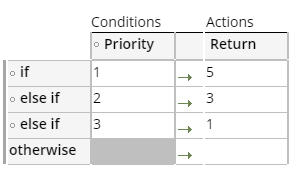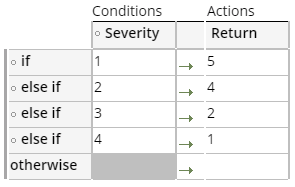Mappings of Agile Workbench values to Jira values
Follow a real-time Agile methodology and manage your projects conveniently and efficiently by integrating Agile Workbench with Jira. By using the Jira component in your application, you can enhance your project management with features such as work and issue tracking.
For greater compatibility between Jira and Agile Workbench, map various values between the two systems:
- User story priorities
- Bug severity
- Jira status categories and Pega stages in a workflow
- Default Jira statuses for Pega stages when moving items on a board
User story priorities
Pega Agile Workbench supports a three-point scale for user story priorities, while Jira uses a wider scale. Use the Pega-Agile-Work-UserStory.GetPriorityForJira decision table to map Agile Workbench default priorities for stories to their equivalents in Jira in the following scenarios:
- On the integration modal, when you export existing Agile Workbench stories to Jira.
- When you create a story in Agile Workbench, the default priority is 1.
- When you spin-off a user story.
The following table shows how to map Jira and Agile Workbench priorities:
| Sample Jira priorities | Agile Workbench mapping |
|---|---|
|  |
The values in the Return column show the priority in Jira. Modify this decision table if you use custom priorities for user stories in Jira.
Bug severity
Pega Agile Workbench supports a four-point scale for bug severity, while Jira uses a wider scale. Use the Pega-Agile-Work-Bug.GetPriorityForJira decision table to map Agile Workbench default bug severity to their equivalents in Jira in the following scenarios:
- On the integration modal when you export Agile Workbench bugs to Jira.
- When you create a bug in Agile Workbench, the default severity is 1.
- When you spin-off a bug.
The following table shows how to map Jira and Agile Workbench bug severity:
| Sample bug severity in Jira | Agile Workbench mapping |
|---|---|
|  |
The values in the Return column show the bug severity in Jira. Modify this decision table if you use custom bug priorities in Jira.
Jira status categories and Pega stages in a workflow
By default, the Pega component for integration with Jira maps Jira status categories and Pega stages for the bugs and stories in a workflow. The following table shows the default mapping:
| Jira status categories | Agile Workbench stages |
|---|---|
| To do | To do |
| In Progress | Doing |
| Done | Done |
One Jira status category contains multiple statuses, for example, the In Progress status category contains In Development, Core Review, and Acceptance Test statuses that Pega Platform maps with respective Agile Workbench stages. The following table shows a default mapping:
| Jira statuses | Agile Workbench stages |
|---|---|
| New | To do |
| In Ideation | To do |
| Grooming | To do |
| In Development | Doing |
| Core Review | Doing |
| Acceptance Test | Doing |
| Done | Done |
The Pega component for Jira maps the statuses and stages when a When rule @baseclass.UseCustomWorkflowMapping is set to false. If you need to use custom mapping, set the When rule to true, and then map the stages and statuses by using the Embed-ProjectMgmt-Pagedata.SetBugStageFormJira and Embed-ProjectMgmt-Pagedata.SetStoryStageFormJira decision tables. For more information, see When Condition rules, Decision tables.
To display the overview for bugs in Agile Workbench, map Jira statuses and Agile Workbench stages by using the Embed-ProjectMgmt-Pagedata.SetBugStageFormJira decision table.
To display the overview for stories in Agile Workbench, map Jira statuses and Agile Workbench stages by using the Embed-ProjectMgmt-Pagedata.SetStoryStageFormJira decision table.
The following table shows how to map Jira statuses and Agile Workbench stages for bugs and stories:
| Statuses in Jira | Agile Workbench mapping |
|---|---|
|  |
The values in the Return column show the stages in Agile Workbench. Modify this decision table if you use custom bug or stories statuses in Jira.
Default Jira statuses for Pega stages when moving items on a board
A scale of Jira statuses and Agile Workbench stages might differ. Additionally, one Agile Workbench stage might reflect multiple Jira statuses. For example, the Doing status in Jira might be mapped with the In Development, In QA, and In Review stages in Pega. In this scenario, when you move a bug or a story on the Agile Workbench board, to display a correct status of an item, map the default Jira statuses to the Pega stages by using the Embed-ProjectMgmt-Pagedata.BugStageToJiraTransition and Pagedata.StoryStageToJiraTransition decision tables.
The following table shows how to map the default Jira statuses to Pega stages when you move items on a board:
| Statuses in Jira | Pega mapping |
|---|---|
|  |
The values in the Return column show the statuses in Jira. Modify this decision table if you use custom bug or stories statuses in Jira.
For more information, see Decision tables, Integrating Agile Workbench with Pega Agile Studio.
Previous topic How to use Application Express advanced features Next topic PMF 6.1.1 - What’s new
